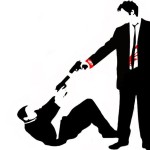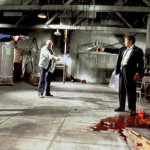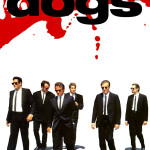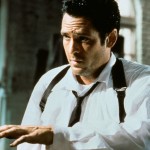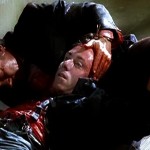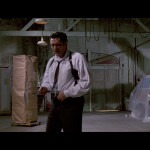Rex malorum est cupiditas (“Greed is the root of all evil”)
Everyone has seen Reservoir Dogs, haven’t they? Haven’t they? Well OK, maybe not everyone, so I shall write this retrospective review for the benefit of those who have not. I’ve told already how I inadvertently chanced upon Tarantino at the Cornerhouse, Manchester, when seeing the movie for the first time, but you don’t need me name-dropping, it’s the movie you need to know about. Firstly, why the title?
He has called it “more of a mood title than anything else.” One popular and oft-told story about the origin of the title is that former video store employee Tarantino used to mangle the title of the French film Au revoir les enfants, and his mispronounciation gave birth to the phrase “Reservoir dogs.”
Next thing to know is that this is an iconic film. Look at the pictures below – this is a movie that has passed down into folklore and popular culture. Witness:
- The image of six guys in black suits, white shirts and black ties mooching down the street to Little Green Bag by the George Baker Selection is celebrated in popular culture and has been referenced many times.
- The ear slicing scene to Stuck in the Middle by Stealer’s Wheel, thanks to Michael Madsen‘s psychopath, Mr Blonde.
- Mr White (Harvey Keitel) and Mr Pink (Steve Buscemi) pointing guns at one another in a Mexican stand-off, one standing, the other prone.
- The intro scene where the men squabble about Like a Virgin and how much to tip the waitress. Assassins talking rubbish is virtually a Tarantino trademark.
- Tim Roth‘s extended death amid a sea of blood as Mr Orange.
In turn, this is Tarantino’s comic book take on Kubrick‘s The Killing, and references The Taking of Pelham 123 by using colours to name the criminals, but then when was any Tarantino film other than derivative? That, and sassy dialogue, are his stock in trade.
Reservoir Dogs is a tragedy with a seam of delicious humour told in three acts: before, during and after the heist, but in the modern vogue is told in fragmented style with the benefit of many flashbacks; linear narrative went out years ago.
The action centres on a bungled diamond heist, set up by virtue of a rat in the camp of Joe Cabot’s (Lawrence Tierney) assembled thugs. “As thick as thieves”? Don’t believe a word of it – these thieves are mutually distrusting guys who spend more time at one another’s throats than acting like cool professionals. They bicker constantly, smoke like chimneys, swear like troopers, analyse their own incompetence and blame everybody but themselves individually.
Even “Nice Guy Eddie” (Chris Penn) seems stressed. Mr Brown (Tarantino himself) and Mr Blue (criminal-turned-screenwriter Edward Bunker) were apparently killed in the botched heist, which may have been a blessing for them, though undercover cop Mr Orange is shot by a witness who did not have access to all the facts. It’s a hard life, going undercover.
The coolest dude is also the most dangerous. Mr Blonde triggered the shoot-out on the job by firing indiscriminately, though whether that came before or after the alarm is not clear. The fatally wounded Mr Orange (aka cop Freddy Newandyke) shoots him dead before he can set one-eared police officer hostage Marvin Nash alight.
In fact, this is a work strongly reminiscent of Chaucer‘s Pardoner’s tale, especially since most of the criminals make a fine job of killing one without the police needing to come in, guns blazing.
The one fact known to Mr White is that Mr Pink claims to have stashed the diamonds in an unknown location, though by the end one is dead and the other apparently arrested by police surrounding the warehouse. Nobody comes out better off, almost all end up dead – which was Chaucer’s point. Well said, Geoffrey!
The success of Reservoir Dogs (described on Wikipedia as a “neo-noir black comedy crime thriller”) is down to the simplicity of its components and the loose plotting, allowing the actors time to breathe and to improvise in character. It shows – they all look comfortable within their skin and ooze confidence in their performances, which surely is what acting is all about – and the essential quotability.
In this case, the currency is not solely words: in the world of cinematic language images are king. As discussed above, they last long in the memory, and, in this case, are considered “cool” even in hindsight. That Tarantino marries his violent and conflicting images to music and inconsequential smalltalk probably makes it all the cooler.
Reservoir Dogs was, by comparison with its contemporaries, zingingly fresh; it tickled the tummies of critics everywhere (see excerpt from Wikipedia’s page below.) Maybe Quentin is suffering diminishing returns and is having to recourse to shock horror tactics – but then big budgets and big egos get in the way. By comparison, the budget ($1.2m) and initial box office ($2.8m) were modest – but the influence of this movie more than compensated.
______
Critical reaction
Reservoir Dogs has come to be seen as an important and highly-influential milestone of independent filmmaking. It has inspired many other independent films and is considered key in the development of independent cinema. Review aggregation website Rotten Tomatoes retrospectively gives the film a 92% based on reviews from 60 critics, and Metacritic carries an average rating of 78/100, based on 23 reviews. Empire magazine named it the “Greatest Independent Film” ever made.
At the film’s release at the Sundance Film Festival, film critic Jami Bernard of the New York Daily News compared the effect of Reservoir Dogs to that of the 1895 film L’Arrivée d’un Train en Gare de la Ciotat, whereby audiences putatively observed a moving train approaching the camera and scrambled. Bernard said that Reservoir Dogs had a similar effect and people were not ready for it Vincent Canby of The New York Times enjoyed the cast and the usage of non-linear storytelling. He similarly complimented Tarantino’s directing and liked the fact that he did not often use close-ups in the film. Kenneth Turan of the Los Angeles Times also enjoyed the film and the acting, particularly that of Buscemi, Tierney and Madsen, and said “Tarantino’s palpable enthusiasm, his unapologetic passion for what he’s created, reinvigorates this venerable plot and, mayhem aside, makes it involving for longer than you might suspect.” Critic James Berardinelli was of a similar opinion; he complimented both the cast and Tarantino’s dialogue writing abilities. Hal Hinson of The Washington Post was also enthusiastic about the cast, complimenting the film on its “deadpan sense of humor”.
Roger Ebert was less enthusiastic; he felt that the script could have been better and said that the film “feels like it’s going to be terrific”, but Tarantino’s script does not have much curiosity about the characters. He also stated that “[Tarantino] has an idea, and trusts the idea to drive the plot.” Ebert gave the film two and a half stars out of four and said that while he enjoyed it and that it was a very good film from a talented director, “I liked what I saw, but I wanted more.”
The film has received substantial criticism for its strong violence and language. One scene that viewers found particularly unnerving was the ear-cutting scene; Madsen himself reportedly had great difficulty finishing it, especially after Kirk Baltz ad-libbed the desperate plea “I’ve got a little kid at home.”[25] Many people walked out during the film. During a screening at Sitges Film Festival, fifteen people walked out, including horror film director Wes Craven and special makeup effects artist Rick Baker. Baker later told Tarantino to take the walkout as a “compliment” and explained that he found the violence unnerving because of its heightened sense of realism. Tarantino commented about it at the time: “It happens at every single screening. For some people the violence, or the rudeness of the language, is a mountain they can’t climb. That’s OK. It’s not their cup of tea. But I am affecting them. I wanted that scene to be disturbing.”
Critical analysis
Reservoir Dogs has often been seen as a prominent film in terms of on-screen violence. J.P. Telotte compared Reservoir Dogs to classic caper noir films and points out the irony in its ending scenes. Mark Irwin also made the connection between Reservoir Dogs and classic American noir. Caroline Jewers called Reservoir Dogs a “feudal epic” and paralleled the color pseudonyms to color names of medieval knights.
Critics have observed parallels between Reservoir Dogs and other films. For its nonlinear storyline, Reservoir Dogs has often been compared to Rashomon. Critic John Hartl compared the ear-cutting scene to the shower murder scene in Psycho and Tarantino to David Lynch. He furthermore explored parallels between Reservoir Dogs and Glengarry Glen Ross. Todd McCarthy, who called the film “undeniably impressive”, was of the opinion that it was influenced by Mean Streets, Goodfellas and The Killing. After this film, Tarantino himself was also compared to Martin Scorsese, Sam Peckinpah, John Singleton, Gus Van Sant, and Abel Ferrara.
A frequently cited comparison has been to Tarantino’s second and more successful film Pulp Fiction, especially since the majority of audiences saw Reservoir Dogs after the success of Pulp Fiction. Comparisons have been made regarding the black humor in both the films, the theme of accidents, and more concretely, the style of dialogue and narrative style that Tarantino incorporates into both films. Specifically the relationship between whites and blacks plays a big part in the films—though underplayed in Reservoir Dogs. Stanley Crouch of The New York Times compared the way the white criminals speak of black people in Reservoir Dogs to the way they are spoken of in Scorsese’s Mean Streets and Goodfellas. Crouch observed the way black people are looked down upon in Reservoir Dogs, but also the way that the criminals accuse each other of “verbally imitating” black men and the characters’ apparent sexual attraction to black actress Pam Grier.
In February 2012, as part of an ongoing series of live dramatic readings of film scripts being staged with the Los Angeles County Museum of Art (LACMA), director Jason Reitman cast black actors in the originally white cast: Laurence Fishburne as Mr. White; Terrence Howard as Mr. Blonde; Anthony Mackie as Mr. Pink; Cuba Gooding Jr. as Mr. Orange; Chi McBride as Joe Cabot; Anthony Anderson as Nice Guy Eddie (Joe Cabot’s son); Common as both Mr. Brown and Officer Nash (the torture victim of Mr. Blonde), and Patton Oswalt as Holdaway (the mentor cop who was originally played by a black actor in the film). Critic Elvis Mitchell suggested that Reitman’s version of the script was taking the source material back to its roots since the characters “all sound like black dudes.”
In an interview featured in the 2011 documentary I Am Fishead, psychologist Robert D. Hare reports that Keitel’s character Mr. White and Madsen’s Mr. Blonde illustrate the differences between the mental health diagnoses of sociopathy and psychopathy. Mr. White is a sociopath, a professional criminal who nonetheless has some loyalty and standards of conduct; he takes no pleasure in violence but regards the use of force as an occasional necessity in his vocation. In contrast, Mr. Blonde enjoys torturing the captured police officer; Mr. White explicitly describes Mr. Blonde as a “psychopath” and condemns his reckless shooting of civilians.
Accolades
The film was screened out of competition at the 1992 Cannes Film Festival. It won the Critic’s Award at the 4th Yubari International Fantastic Film Festival in February 1993 which Tarantino attended.[36] The film was also nominated for the prestigious Grand Prixof the Belgian Syndicate of Cinema Critics.
American Film Institute Lists
- AFI’s 100 Years…100 Thrills – Nominated
- AFI’s 100 Years…100 Heroes and Villains:
- “Mr. Blonde” (Vic Vega) – Nominated Villain
- AFI’s 100 Years…100 Songs:
- Stuck in the Middle with You – Nominated
- AFI’s 100 Years…100 Movie Quotes:
- “Are you gonna bark all day, little doggie, or are you gonna bite?” – Nominated
- AFI’s 10 Top 10 – Nominated Gangster Film
Reservoir Dogs ranks at No. 97 in Empire magazine’s list of the 500 Greatest Films of All Time.


